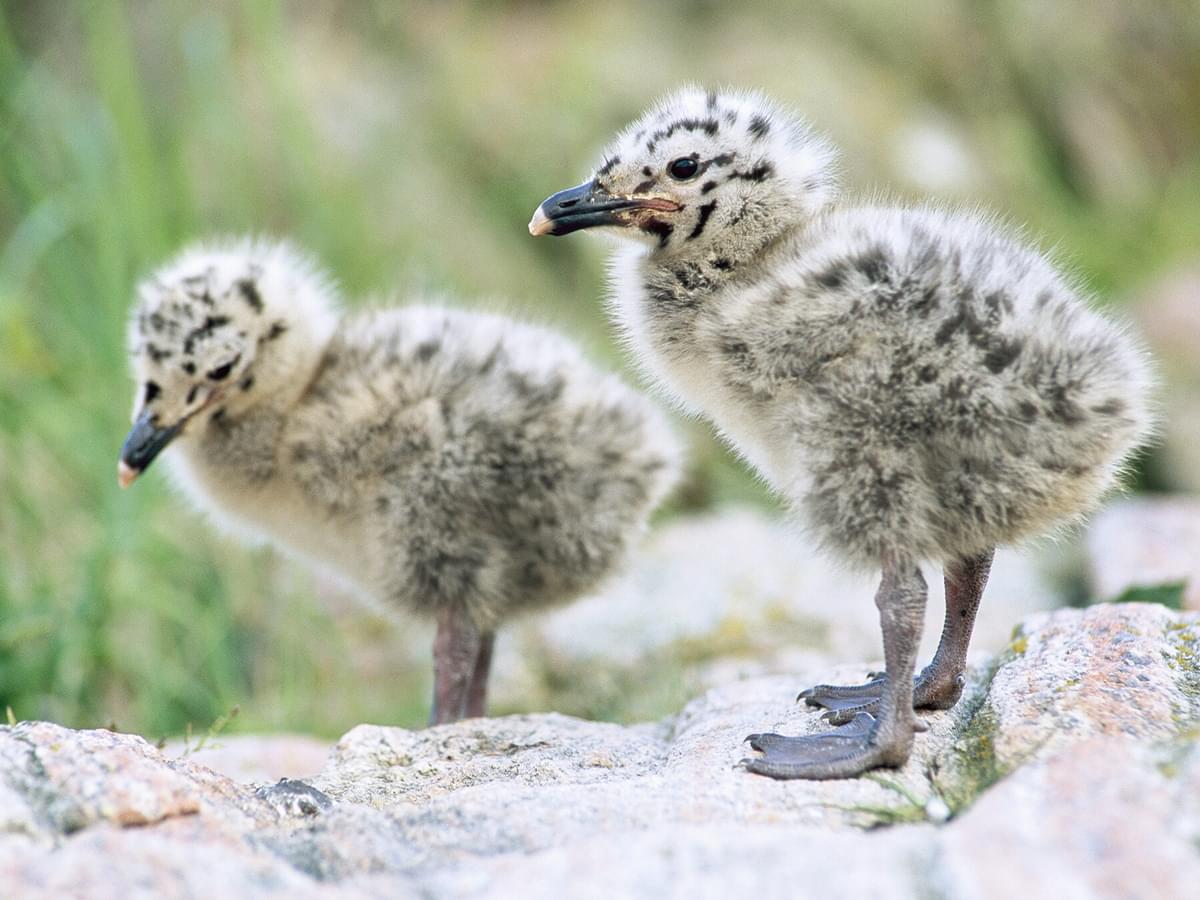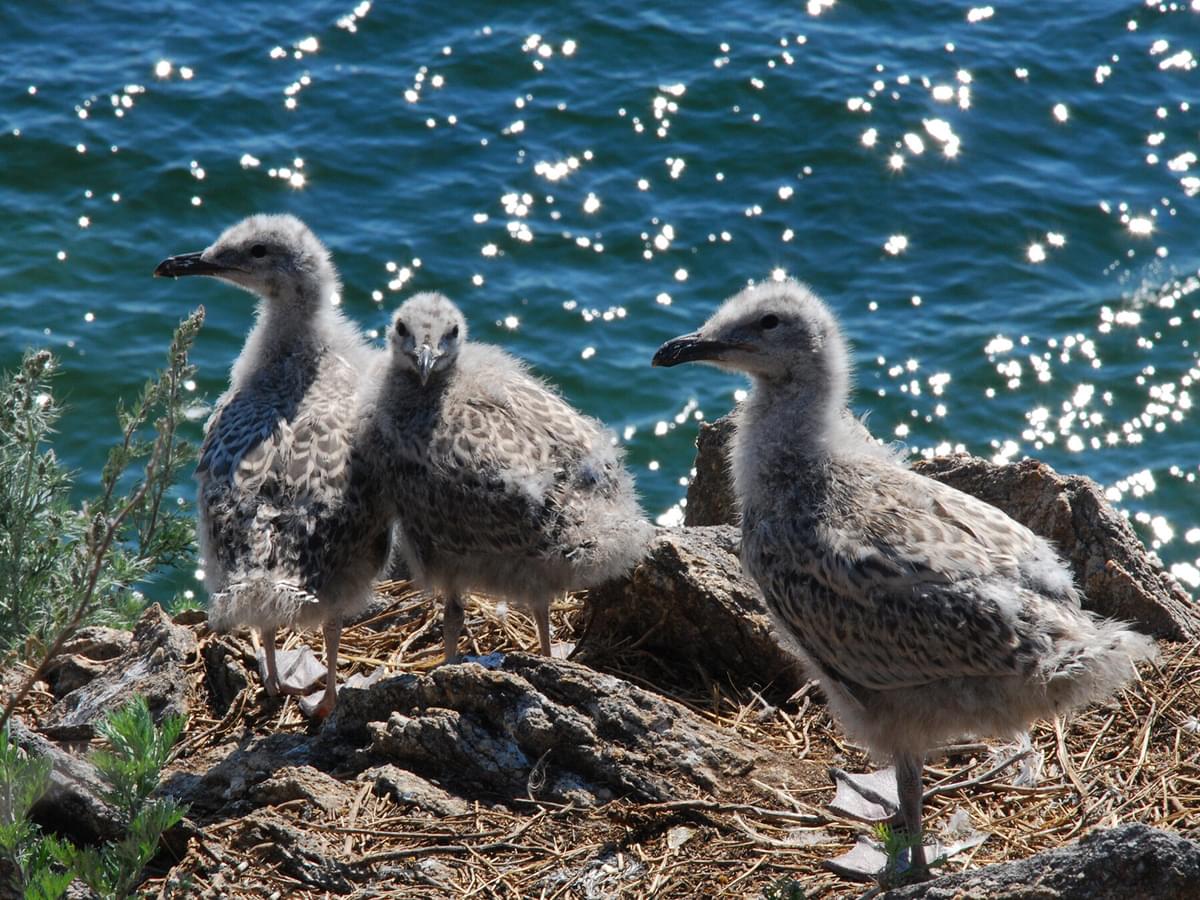Gulls, or seagulls as they’ve come to be known colloquially, are an extremely familiar sight across much of the world. They live on every continent including the High Arctic and Antarctic!
Despite seagulls being incredibly widespread and numerous, baby seagulls remain a quite rare sight. This article will explore everything to do with baby seagulls - and there will be plenty of photos of baby seagulls too!
What does a baby seagull look like?
Baby seagulls are known for being very cute and fluffy. Their looks do depend on the species, as there are 54 species of gulls, but most seagull chicks are covered in a soft speckled or mottled brown down, which is thick and fluffy.
Sometimes they just have speckled heads, but usually, the whole body is covered in spots or mottles.
This does vary, though. Baby Kittiwakes are much more white, or grey than brown and have mottled grey wings. The chicks of most gull species do look similar, though, only differing slightly in terms of their size, colouration and proportions.

Two seagull chicks
How big is a baby seagull?
It really depends on the species. The smallest species of gull, the Little gull, has an approximate body length of 30cm, a wingspan of around 61 to 78cm, and a mass of 68 to 162g.
The largest, the Great Black-Backed gull, measures 64 to 79cm long and has a 1.5 to 1.7m wingspan, weighing up to 2.5kg.
The chicks of these species are likely wildly different in size, even if they did look quite similar!
There’s little data available for the sizes of different gull chicks, but judging by the egg sizes, most seagull chicks are likely similarly sized to a duckling. Of course, this will vary - Little gull chicks will be tiny, for example.
How much do baby seagulls weigh?
There’s little consistent data on the weights of baby gulls. There is one study into the weight of Herring gulls which found the average weight at five days old to be around 50 grams.
Fifty grams is probably a solid average for the weight of many medium to larger-sized gulls, including the Herring gull, Common gull and Lesser Black-Backed gull. Smaller species of gulls will be considerably lighter as there’s plenty of size and weight variability between different gulls.

Black-headed Gull chick
What do juvenile seagulls look like?
Juvenile seagulls take some four years to reach maturity, at which point they’ll resemble a fully-grown gull with fully-developed plumage.
Juvenile seagulls are still predominantly brown or mottled grey for the entire first year of their life, usually featuring plenty of shaggy, downy feathers up their bodies and necks.
In their second year, these flecks begin to subside as more white and grey comes through, particularly on the upper wings. The beak also begins to change colour, turning more pink-yellow.
By the third year, gull heads start turning to their adult colour, usually white. Brown plumage begins to turn to grey and white. For many species, the juvenile’s beak will turn yellow.

A juvenile Herring Gull with a mottled plumage
What is a baby seagull called?
Baby seagulls are typically just called gull chicks. They don’t have specialised names like owlets, eaglets, etc.
What is a group of baby seagulls called?
In the early days, gull parents are extremely protective over their chicks and wouldn’t let them socialise in a group of baby seagulls. This continues until the bird fledges and joins a flock of seagulls, often with other juveniles.
This can take a while, and very young gulls are often spotted on their own and isolated for some time before they tag on to a larger flock of grown birds.
A group of adult or juvenile gulls is typically just called a colony or a flock.

Three baby seagull nestlings, huddled together in a nest
What do baby seagulls eat?
Baby seagulls eat whatever their parents feed them, which includes, well, pretty much anything, actually! Most of this food will be regurgitated by the parents.
Gulls are unfussy omnivores that eat anything from human scraps to fish and plant matter. Their primary diet really depends on what types of food are abundant in their environments.
Both gull parents typically feed the chicks some 3 to 6 times a day, which isn’t too often compared to most other birds. Foods include anything the parents deem soft enough for the chick to eat, which includes scraps of soft or water-sodden foods as well as partially digested and regurgitated meals.

A seagull feeding a recently hatched chick
How do seagulls feed their chicks?
Both seagull parents usually participate in feeding the chicks and feed them both soft scraps and regurgitated food. During the first week or two, the chicks will call near-constantly for their parents, who will return at various times of day to feed the chicks. Regurgitative feeding continues at least until the gull chick fledges the nest, typically after 5 to 6 weeks.
In some species, such as the Herring gull, parental feeding does not stop when the gull chick fledges. Herring gulls may feed their post-fledgling chicks for another two months or so, and the fledglings may stay with their parents for much of the year.

A seagull feeding two of their chicks
What do seagull eggs look like?
Most gull eggs are well-camouflaged in olive, green or browny-green hues. Some species have browner eggs whilst others have greener eggs, but broadly speaking, they all look very similar and tend to blend in very well with their mossy or rocky environments.

Three common gull eggs in the nest, beginning to hatch
How long do seagull eggs take to hatch?
Gull eggs tend to hatch after around 30 to 32 days of incubation. In some species, like the Kittiwake, this might extend as low as 28 days.
When do seagulls lay eggs?
In much of Europe, gulls tend to lay eggs around late April or May. In America, it’s usually slightly earlier in March or early April.
As gulls get closer to the equator or other warm regions, this standard breeding season begins to apply more loosely. For example, Swallow-tailed gulls live around the Galapagos and have no defined breeding season, breeding all year round.
How fast do seagull chicks grow?
Seagull chicks grow quickly, doubling in body weight after just a few days. They’re generally very active even after just a few days after being born and tend to roam the area around the nest, sometimes even wandering off a considerable distance.
This might lead people to think the chick has been abandoned by its parents, especially if it pops up in a seemingly inappropriate or unsafe location, but rest assured, gull parents are vigilant and aware and will likely usher the wayward chick back to safety!

Three seagull chicks, that have grown considerably fast
How large is a seagull clutch?
The vast majority of gull species lay between 2 to 4 eggs, with 3 being a consistent average. If three chicks hatch, then only one or two will likely survive.
When can baby seagulls fly?
Depending on the species, most baby gulls can fly after 6 to 8 weeks. 45 days is a typical average.
Fledglings generally fail to fly properly for a few days, and this is a risky time as they may end up exposed in vulnerable locations. The parents encourage flight, both through vocalisations and also by temporarily withholding food.

Juvenile seagull in flight
When do baby seagulls leave their nests?
Baby gulls are generally quite active even days after hatching and tend to leave their nest to roam to the immediate vicinity.
They won’t properly leave the nest for at least 4 to 8 weeks, though, and some species stay around their nesting sites for up to 6 months.
Do seagulls reuse nests?
Many species of gulls such as the Franklin’s gull, Black-backed gull and Glaucous gulls are strongly migratory, leaving their breeding grounds each winter to roost in warmer regions. They typically return to the exact same breeding grounds with pinpoint accuracy. Studies have found that the gull’s sense of smell may play a part in their incredible navigation skills.
Gull nests are pretty substantial and robust, but they’d rarely last all year long, so breeding pairs will generally construct a new nest each year, which takes roughly two weeks. It is possible that they’d reuse the nest or nesting material if the nest survives intact.

A family of Ring-billed gulls with two chicks
How long do baby seagulls stay with their parents?
This really depends on the species, as some gull chicks gain some independence from their parents within a window of around 6 to 8 weeks, whereas others stay with their parents for much of the year.
The Herring gull is one such species - Herring gull parents even continue to regurgitate feed their chicks until they’re well past the fledgling stage. Juvenile gulls tend to linger around their parents and nearby flocks for some time until they reach maturity. These are patient and long-lived birds that do not breed for some 3 to 4 years after birth.

A seagull baby exploring a short way from the nest
Do baby seagulls drink water?
In the wild, baby seagulls will get much of their water from their food.
Gulls are one of few birds who are able to efficiently filter salt from saltwater, enabling them to drink both fresh and saltwater. This nasal gland found near the eye is present in most birds, but is inactive in the vast majority, with the exception of marine birds who spend much of their time at sea.
In gulls, this gland efficiently removes sodium chloride (salt) from the blood, enabling them to drink both sea and freshwater.
